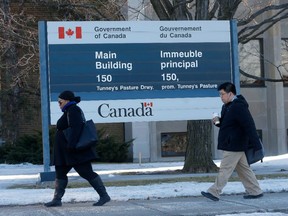Unions are ramping up efforts to fight the new return-to-office requirements that come into effect Sept. 9

The federal government is rolling out its new remote work rules next week that will require many employees to be back in the office at least three days a week.
Since the end of March, 2023, the Treasury Board has required public servants to work in offices for a minimum of two days a week. But that will change on September 9.
Here’s everything you need to know about the updated mandate.
THIS CONTENT IS RESERVED FOR SUBSCRIBERS ONLY
Subscribe now to read the latest news in your city and across Canada.
- Exclusive articles from Elizabeth Payne, David Pugliese, Andrew Duffy, Bruce Deachman and others. Plus, food reviews and event listings in the weekly newsletter, Ottawa, Out of Office.
- Unlimited online access to Ottawa Citizen and 15 news sites with one account.
- Ottawa Citizen ePaper, an electronic replica of the print edition to view on any device, share and comment on.
- Daily puzzles, including the New York Times Crossword.
- Support local journalism.
SUBSCRIBE TO UNLOCK MORE ARTICLES
Subscribe now to read the latest news in your city and across Canada.
- Exclusive articles from Elizabeth Payne, David Pugliese, Andrew Duffy, Bruce Deachman and others. Plus, food reviews and event listings in the weekly newsletter, Ottawa, Out of Office.
- Unlimited online access to Ottawa Citizen and 15 news sites with one account.
- Ottawa Citizen ePaper, an electronic replica of the print edition to view on any device, share and comment on.
- Daily puzzles, including the New York Times Crossword.
- Support local journalism.
REGISTER / SIGN IN TO UNLOCK MORE ARTICLES
Create an account or sign in to continue with your reading experience.
- Access articles from across Canada with one account.
- Share your thoughts and join the conversation in the comments.
- Enjoy additional articles per month.
- Get email updates from your favourite authors.
Sign In or Create an Account
or
Who does the government’s new policy on remote work apply to?
The new directive applies to all core public administration staff employed under the Treasury Board, including full-time, part-time, term employees, students and casual workers. As of June, this included more than 282,000 workers.
The policy also applies to employees working at some separate federal departments and agencies. While a Treasury Board message to deputy ministers shared in May said that separate agencies were “strongly encouraged” to implement a similar remote work plan, some are divided on whether to adopt the government mandate, with some still exploring options.
As of mid-August, departments and agencies that had chosen to adopt the updated rules included the National Research Council of Canada, Parks Canada, the Communications Security Establishment, the Financial Transactions and Reports Analysis Centre of Canada, the Office of the Correctional Investigator, the Canadian Food Inspection Agency, the Office of the Superintendent of Financial Institutions, the Canadian Institutes of Health Research and the Canada Revenue Agency.
Are there any exceptions to the policy?
The Treasury Board’s directive outlines several potential exceptions, including for those hired to work remotely before March 16, 2020, for Indigenous public servants “whose location is critical to their identity to work from their communities” and for employees who, with the permission of their assistant deputy minister, live 125 kilometres or more from their designated workplace.
A Treasury Board guide for deputy heads and departmental heads of human resources said exemptions will be made “on a case-by-case basis on a time-limited or longer-term duration.”
A previous version of the online policy noted that the government is no longer offering any group exceptions, including for call centre and information technology employees. It said the transition to the three-day minimum requirement may require more time for these employees and organizations to adapt, with full implementation expected by next year.
Can an employee be fired for breaking the rules?
According to the guide, when an employee deliberately fails to comply with a telework agreement, managers should consult with their labour relations experts and consider applying “relevant and progressive discipline” to correct the behaviour. It said typical steps include verbal reprimand, written reprimand, suspension without pay of escalating duration and termination of employment, but they can be taken in varying orders.
“Before taking any of the above measures, managers should ensure that individual circumstances are considered on a case-by-case basis, including human rights obligations, such as the duty to accommodate, or whether an employee has a reasonable explanation for the behaviour,” the guide said.
Why did the government update the policy?
The Treasury Board has argued that in-person work is necessary for team building.
In an email, deputy clerk of the Privy Council Christiane Fox said having staff work together onsite “strengthens collaboration within, and across teams and, increases opportunities for learning and sharing.” She said it’s not strictly about individual performance and productivity, but about the public service as a whole.
“Public Service is a team sport,” Fox said, adding that working in person will allow new and young public servants to have more opportunities to build relationships, learn, and be better prepared to take on more senior roles.
While the government’s motivation was to be as high performing as possible, Fox said the government also “cannot ignore the perception of the public service,” which is directly related to the trust and confidence of Canadians.
“The decision is based on the continuous assessment of the public service from the onset of the pandemic and where we are today,” Fox said. “We are committed to hybrid, however, we feel there is a gap in spending less time working as teams and we are addressing that.”
How are unions fighting the remote work mandate?
Several federal unions have contested that decision since it was announced in early May, holding rallies, filing complaints, encouraging members to submit grievances, sending open letters and launching petitions. They have stated that the decision was made without consultation and was unsupported by evidence, given that Treasury Board did not complete any studies on collaboration or productivity.
Unions have also argued that the government is catering to downtown business coalitions and to politicians like Ontario Premier Doug Ford who called for federal workers to get back to the office. However, Treasury Board President Anita Anand has stressed that the move was not a political decision.
In early fall, the Public Service Alliance of Canada plans to ramp up its efforts to “fight back” against what it has called a misguided and unilateral mandate through a $1-million telework campaign. The union aims to use the national campaign to fight for telework in court and during contract negotiations, which are expected to begin again in spring 2025.
Federal unions are planning to hold a “rally for remote rights” on the morning of September 9 at the Immigration, Refugees and Citizenship Canada building in downtown Ottawa.
And last week, the Federal Court announced that it will review a case launched by the Public Service Alliance of Canada seeking to quash the federal government’s new remote work rules.
The Treasury Board has argued that it has the management right to choose employees’ location of work and to require them to report to their designated workplace.
Are any federal organizations delaying employees’ increased return to the office?
Unions and employees have expressed concern about the new mandate, noting that there is a lack of office space or desks for employees to work in government buildings.
The Canada Revenue Agency (CRA) said in July that while it was aligning with the federal public service’s updated hybrid work model, it did expect “some differences in the timing and application” of the new direction for some employees due to real property availability.
The CRA “is currently working diligently to identify existing space availability and areas where additional space may be required to meet its mandate,” the agency said in an email, adding that its plans were not finalized.
Our website is your destination for up-to-the-minute news, so make sure to bookmark our homepage and sign up for our newsletters so we can keep you informed.
Share this article in your social network



